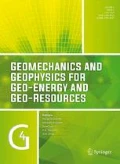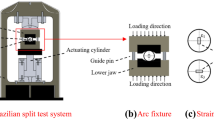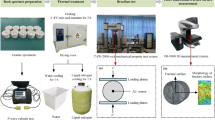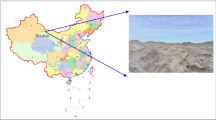Abstract
Investigation of temperature dependent tensile strength characteristics of rocks provides essential inputs to continue the development of deep geo-engineering applications, including enhanced geothermal systems, deep mining and deep geological disposal of nuclear waste. The aim of this study is, therefore, to identify the influence of temperature (from room temperature to 1000 °C) and different heating and cooling treatments (constant high temperature, slow and rapid cooling) on Australian granite’s tensile strength and to investigate the corresponding microstructural alterations due thermal treatment. Brazilian tensile strength tests were performed on two types of granites collected from Australia, Strathbogie, and Harcourt. ARAMIS photogrammetry, Acoustic Emissions (AE) and Scanning Electron Microscopy (SEM) were employed to examine the crack initiation and development during the experiment. The results concluded that with the increase of temperature for all three thermal conditions, there was a slight increase in tensile strength for Strathbogie granite between room temperature and 200 °C for constant high-temperature condition and slowly cooled condition whilst beyond this there was a clear negative trend. Harcourt granite experienced a negative trend immediately from room temperature conditions. Further, the influence of rapid cooling was much higher than that of slow cooling, due to the intense thermal shock. Beyond 500 °C, there was a significant reduction in the range of strength values which evidence α to β quartz mineral transition. Therefore, the failure mechanism of granite at considered temperature transitioned from a brittle to a quasi-brittle state. This was confirmed with AE testing and ARAMIS photogrammetry such that, higher temperatures resulted in a considerable crack closure and an increase in the unstable crack propagation. This was mainly due to the closure of pre-existing thermally induced cracks followed by crack re-bonding due to the melting followed by re-crystallization of grains, particularly at 1000 °C which was confirmed with SEM.









Similar content being viewed by others
References
ASTM, D (2016) Standard test method for splitting tensile strength of intact rock core specimens1. ASTM International, West Conshohocken
Barla G (2017) Comprehensive study including testing, monitoring and thermo-hydro modelling for design and implementation of a geothermal system in Torino (Italy). Geomech Geophys Geo Energy Geo Resources 3(2):175–188
Bauer S, Johnson B (1979) Effects of slow uniform heating on the physical properties of the Westerly and Charcoal granites. In: 20th US symposium on rock mechanics (USRMS). American Rock Mechanics Association
Breede K, Dzebisashvili K, Liu X, Falcone G (2013) A systematic review of enhanced (or engineered) geothermal systems: past, present and future. Geotherm Energy 1(1):4
Brookins DG (2012) Geochemical aspects of radioactive waste disposal. Springer, Berlin
Cameron Huddlestone-Holmes TH, Ashleigh C, Jenny Hand Chaoen L (2015) Geothermal heat use in gas processing facilities. CSIRO, Canberra
Chang S-H, Lee C-I (2004) Estimation of cracking and damage mechanisms in rock under triaxial compression by moment tensor analysis of acoustic emission. Int J Rock Mech Min Sci 41(7):1069–1086
Dobson P, Asanuma H, Huenges E, Poletto F, Reinsch T, Sanjuan B (2017) Supercritical geothermal systems-a review of past studies and ongoing research activities. In: 42nd workshop on geothermal reservoir engineering, Stanford University, Stanford, California
Dwivedi RD, Goel RK, Prasad VVR, Sinha A (2008) Thermo-mechanical properties of Indian and other granites. Int J Rock Mech Min Sci 45(3):303–315
Feng CY (2013) Enhanced geothermal systems projects and its potential for carbon storage, advanced materials research. Trans Tech Publications, Stafa-Zurich, pp 109–115
Fujii Y, Takemura T, Takahashi M, Lin W (2007) Surface features of uniaxial tensile fractures and their relation to rock anisotropy in Inada granite. Int J Rock Mech Min Sci 44(1):98–107
Griffith AA (1921) The phenomena of rupture and flow in solids. Philos Trans R Soc Lond Ser A Math Phys Character 221:163–198
Haimson B, Cornet F (2003) ISRM suggested methods for rock stress estimation—part 3: hydraulic fracturing (HF) and/or hydraulic testing of pre-existing fractures (HTPF). Int J Rock Mech Min Sci 40(7):1011–1020
Heuze F (1983) High-temperature mechanical, physical and thermal properties of granitic rocks—a review. Int J Rock Mech Min Sci Geomech Abstr Elsevier 20:3–10
Hoek E (1964) Fracture of anisotropic rock. J South Afr Inst Min Metall 64(10):501–523
Hoek E, Brown ET (1997) Practical estimates of rock mass strength. Int J Rock Mech Min Sci 34(8):1165–1186
Homand-Etienne F, Houpert R (1989) Thermally induced microcracking in granites: characterization and analysis. Int J Rock Mech Min Sci Geomech Abstr 26(2):125–134
Hubbert MK, Willis DG (1957) Mechanics of hydraulic fracturing. Soc Pet Eng 210:153–163
Hucka V, Das B (1974) Brittleness determination of rocks by different methods. Int J Rock Mech Min Sci Geomech Abstr Elsevier 11:389–392
Hueckel T, Peano A, Pellegrini R (1994) A thermo-plastic constitutive law for brittle-plastic behavior of rocks at high temperatures. Pure Appl Geophys 143(1–3):483–510
ISRM (1978) Suggested methods for determining tensile strength of rock materials. Int J Rock Mech Min Sci Geomech Abstr 15(3):99–103
Jeyaprabha B, Elangovan G, Prakash P (2016) Effects of elevated temperature and water quenching on strength and microstructure of mortars with river sand substitutes. Constr Build Mater 114:688–698
Kahraman S, Altindag R (2004) A brittleness index to estimate fracture toughness. Int J Rock Mech Min Sci 41(2):343–348
Kim H, Jang J, Choi Y, Lee H (2014) Improved chloride resistance of high-strength concrete amended with coal bottom ash for internal curing. Constr Build Mater 71:334–343
King RL, Weston KS (1997) Dimension stone in Victoria, Geological Survey of Victoria, Report 112, Melbourne
Kneafsey TJ, Dobson P, Blankenship D, Morris J, Knox H, Schwering P, White M, Doe T, Roggenthen W, Mattson E, Podgorney R, Johnson T, Ajo-Franklin J, Valladao C, and team, t.E.C. (2018). An overview of the EGS Collab project: field validation of coupled process modeling of fracturing and fluid flow at the sanford underground research facility, Lead, SD. In: 43rd Workshop on Geothermal Reservoir Engineering, Stanford University, Stanford, California
Kumari W, Ranjith P, Perera M, Chen B, Abdulagatov I (2017) Temperature-dependent mechanical behaviour of Australian Strathbogie granite with different cooling treatments. Eng Geol 229:31–44
Kumari WGP, Ranjith PG, Perera MSA, Chen BK (2018) Experimental investigation of quenching effect on mechanical, microstructural and flow characteristics of reservoir rocks: thermal stimulation method for geothermal energy extraction. J Petrol Sci Eng 162:419–433
Kuncoro GB (2015) Fluid-rock interaction studies on an enhanced geothermal system in the Cooper Basin, South Australia. Doctoral dissertation, University of Adelaide
Lockner D (1993) The role of acoustic emission in the study of rock fracture. Int J Rock Mech Min Sci Geomech Abstr Elsevier 30:883–899
Nazir R, Momeni E, Armaghani DJ, Amin MM (2013) Correlation between unconfined compressive strength and indirect tensile strength of limestone rock samples. Electr J Geotech Eng 18:1737–1746
Ohno I (1995) Temperature variation of elastic properties of alpha quartz up to the alpha beta transition. J Phys Earth 43(2):157–169
Perras MA, Diederichs MS (2014) A review of the tensile strength of rock: concepts and testing. Geotech Geol Eng 32(2):525–546
Phillips G, Clemens J (2013) Strathbogie batholith: field-based subdivision of a large granitic intrusion in central Victoria, Australia. Appl Earth Sci 122(1):36–55
Ranjith P, Jasinge D, Song J, Choi S (2008) A study of the effect of displacement rate and moisture content on the mechanical properties of concrete: use of acoustic emission. Mech Mater 40(6):453–469
Rao Q-H, Wang Z, Xie H-F, Xie Q (2007) Experimental study of mechanical properties of sandstone at high temperature. J Cent South Univ Technol 14:478–483
Rybach L (2014) Geothermal power growth 1995–2013—a comparison with other renewables. Energies 7(8):4802–4812
Shao S, Wasantha PLP, Ranjith PG, Chen BK (2014) Effect of cooling rate on the mechanical behavior of heated Strathbogie granite with different grain sizes. Int J Rock Mech Min Sci 70:381–387
Shao S, Ranjith P, Wasantha P, Chen B (2015) Experimental and numerical studies on the mechanical behaviour of Australian Strathbogie granite at high temperatures: an application to geothermal energy. Geothermics 54:96–108
Singh B, Ranjith P, Chandrasekharam D, Viete D, Singh H, Lashin A, Al Arifi N (2015) Thermo-mechanical properties of Bundelkhand granite near Jhansi, India. Geomech Geophys Geo Energy Geo Resources 1(1–2):35–53
Tapponnier P, Brace W (1976) Development of stress-induced microcracks in Westerly granite. Int J Rock Mech Min Sci Geomech Abstr Elsevier 13:103–112
Török A, Török Á (2015) The effect of temperature on the strength of two different granites. Cent Eur Geol 58(4):356–369
Tullis J, Yund RA (1977) Experimental deformation of dry Westerly granite. J Geophys Res 82(36):5705–5718
Vaughan PJ, Moore DE, Morrow CA, Byerlee JD (1986) Role of cracks in progressive permeability reduction during flow of heated aqueous fluids through granite. J Geophys Res Solid Earth 91(B7):7517–7530
Wang SH, Lee CI, Ranjith PG, Tang CA (2009) Modeling the effects of heterogeneity and anisotropy on the excavation damaged/disturbed zone (EDZ). Rock Mech Rock Eng 42(2):229–258
Wang Y, Li C, Hu Y, Mao T (2017) Brazilian test for tensile failure of anisotropic shale under different strain rates at quasi-static loading. Energies 10(9):1324
Yang S-Q, Tian W-L, Ranjith PG (2017a) Failure mechanical behavior of australian strathbogie granite at high temperatures: insights from particle flow modeling. Energies 10(6):756
Yang SQ, Ranjith PG, Jing HW, Tian WL, Ju Y (2017b) An experimental investigation on thermal damage and failure mechanical behavior of granite after exposure to different high temperature treatments. Geothermics 65(1):180–197
Yin T, Li X, Cao W, Xia K (2015) Effects of thermal treatment on tensile strength of Laurentian granite using Brazilian test. Rock Mech Rock Eng 48(6):2213–2223
Yong C, Wang Cy (1980) Thermally induced acoustic emission in Westerly granite. Geophys Res Lett 7(12):1089–1092
Zhu C, Arson C (2015) A model of damage and healing coupling halite thermo-mechanical behavior to microstructure evolution. Geotech Geol Eng 33(2):389–410
Author information
Authors and Affiliations
Corresponding author
Additional information
Publisher’s Note
Springer Nature remains neutral with regard to jurisdictional claims in published maps and institutional affiliations.
Rights and permissions
About this article
Cite this article
Kumari, W.G.P., Beaumont, D.M., Ranjith, P.G. et al. An experimental study on tensile characteristics of granite rocks exposed to different high-temperature treatments. Geomech. Geophys. Geo-energ. Geo-resour. 5, 47–64 (2019). https://doi.org/10.1007/s40948-018-0098-2
Received:
Accepted:
Published:
Issue Date:
DOI: https://doi.org/10.1007/s40948-018-0098-2




